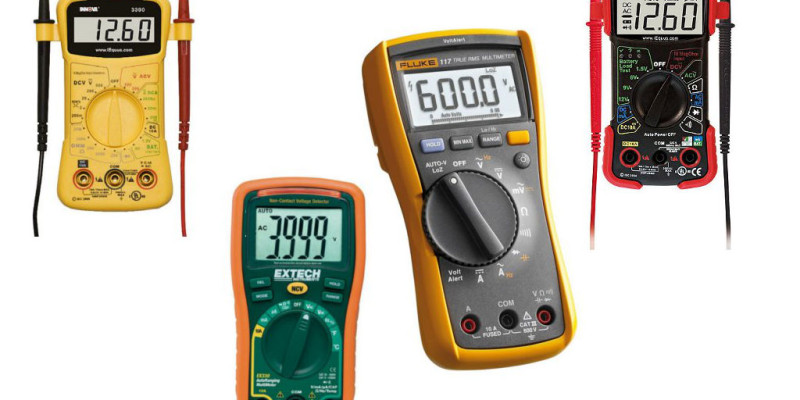What Is A Multimeter?
A multimeter is an important tool when dealing with electronics. Also known as a Volt-Ohm meter, a multimeter allows you to measure several different attributes of an electronic circuit, such as resistance, current and voltage. As some of the cheaper multimeters won't measure current, you can use our Ohm's Law Calculator in combination with checking the voltage and resistance to find the current draw of a circuit.
There are 2 different types of multimeter: Analog and digital. An analog multimeter uses a dial with a pointer to display a measurement, whereas a digital multimeter uses a digital screen to display numerical values. Digital multimeters are more common, and for simple electronics a digital multimeter is the best option. If you're not sure how to use a multimeter, we have a handy guide in our learn section.
Multimeters are generally hand held devices, and are useful for quick fault finding in a circuit. Checking a circuit's completeness and the voltage from a power source are two common uses. There are, however, mains powered, bench multimeters which are used for much more accurate measurements and diagnostics.
Multimeter Reviews
We have updated the reviews for 2024. Rather than review every single multimeter on the market, we've rounded up the multimeter reviews into the following 4 categories:
- Best Budget Multimeter
- Best Intermediate Multimeter
- Best High-End Multimeter
- Best Clamp Multimeter
- Best Bench Multimeter
Best Budget Multimeter
There's a plethora of different cheap multimeters on the market, and for simple testing of circuits these are fine. They main problems with cheap multimeters are the cheap construction and inaccurate readings. However the best multimeter for less than 20 bucks is the ...
AstroAI 2000
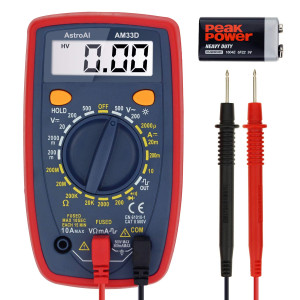
The AstroAI 2000 is just about the best multimeter you can get for a few dollars. It's accurate enough for most uses, and seems rugged enough for a beginner to abuse, or as a handy spare to have knocking around in the garage. The probes do seem a little flimsy, but use a standard fit if you ever need to replace them.
It doesn't feature auto-ranging detection - it's not too difficult to turn the dial to the correct range, but it's a minor annoyance when you just want to quickly check something. It features a handy stand to get a bit of angle towards you, which can help if you get reflections of an overhead light. It doesn't have an auto-off feature, so make sure you turn it off or you'll get a dead battery before you know it.
All in all the AstroAI 2000 is a great little budget unit, and more than adequate for most simple uses. You will struggle to find a better multimeter for less than $20 - it's clear why it's the number 1 best seller on Amazon, but the lack of auto-ranging and poor screen might cause frustration for anything other than very infrequent use.
Buy now from Amazon for $12.99
Best Intermediate Multimeter
A cheap multimeter is fine for simple tests, but if you can stretch the extra little bit, you might want to get something a little better....
AstroAI 6000
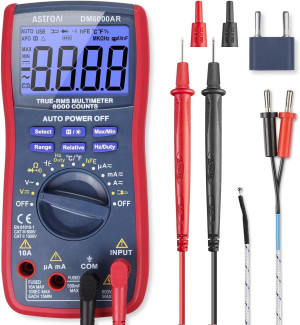
The AstroAI 6000 is a great little multimeter. It's much better than the AstroAI 2000 we've reviewed above. The build quality is excellent for such an inexpensive unit, and the display is nice and clear with a bright backlight. The probes feel much more sturdy and have caps to help limit damage when you throw it into your toolbox. The additional temperature sensor is a nice touch, as is the multi-socket which lets you directly insert capacitors for testing.
A quality-of-life improvement you get with this over a cheaper unit is the auto-ranging function, which means you don't have to select your input range. It recognises what you are testing, and outputs the desired measurement. It can also detect frequency and duty cycle of AC circuits, and features a handly hold option.
The AstroAI 6000 is the best multimeter you can buy before you start competing with the big boys. It has features of more expensive units, but with a lower price. If I were to recommend a multimeter for beginners, I don't think you'd go wrong with this one.
Buy now from Amazon for $26.98
Best High-End Multimeter
If you're serious about testing circuitry, you can't get better than a Fluke multimeter. The 110 series is Fluke's cheapest range, but the 117 featured here is the best of the range. Fluke don't do cheap, they do good.
Fluke 117
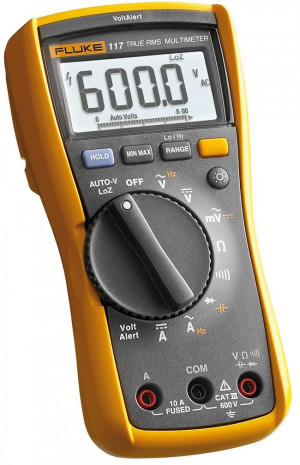
Fluke are regarded as the best multimeters on the planet, and the Fluke 117 is on the 'budget' end of Fluke multimeters. It's solidly built, as are all Flukes. It's a true RMS multimeter and designed with the engineer in mind. It features everything you could possibly need; it can measure resistance, continuity, frequency and capacitance, and has the mix/max/average you need to test fluctuating signals.
The backlit display makes it easy to see the reading in any kind of light. This makes a big difference in demanding situations. The low impedance input helps give accurate reading that are caused by ghost voltage. It can handle a ridiculous amount of power and current: up to 600V and 10A!
The Fluke 117 is aimed at professional engineers and not for hobbyists tinkering with 5V electronics, but it will still do the job. If you need to accurately test simple and household circuits and require a reliable multimeter that can be calibrated (and have the money to spend), then the 117 is all you will ever, ever need.
Buy now from Amazon for $228.00
Best Clamp Multimeter
Testing if wires are live when you can't get to the end connections can cause headahces - that's when a clamp multimeter comes into its own.
Fluke 302+
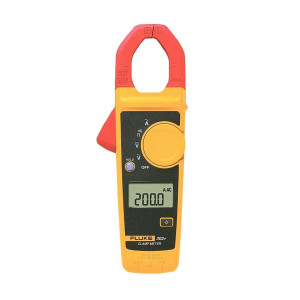
If you find yourself doing a lot of AC work, you'll soon come across a time when you need to know if a cable is carrying a current. This poses a problem as it's not always easy to get to the end connections to vest for voltage, or wire up a shunt to check a current. A clamp meter solves this - simply open the jaws, and wrap it around a cable, and the mutlimeter will show how many amps are running through the wire.
The Fluke 302+ is perfect for this kind of job. As it's make by the best in the business, you know it'll be accurate, and more importantly, safe. The measurements seem fairly accurate, and although it's a compact little unit it feels rugged enough to throw around.
It features voltage measurements as well as continuity testing, so can do basic tasks when working with smaller circuits. It does lack resistance testing though, so if you need this feature, you might want to look elsewhere.
You can get cheaper, more featured clamp multimeters from other sellers, but if you want accuracy that'll last for years, Fluke is the way to go.
Buy now from Amazon for $67.00
Best Bench Multimeter
Bench multimeters are perfect if portability isn't an issue, and have a much better feature set.
OWON XDM1241

If you're serious about electronics work, and don't need to lug it around often, a bench multimeter offers unparalleled features compared to the portable ones we've reviewed above.
The first thing you notice with the XDM1241 is the massive colour screen, offering extreme accuracy with your measurements. This can show multiple values at once, such as the min/max/average. This is invaluble for example when switching powerful motors causing voltage drop and current spikes.
Along with showing data, it can also record values. You can either do this manually, or using a time interval. This data can then be easily export to your computer using the supplied USB cable. It has all the functionality you expect, such as voltage, current, continuity, resistance and temperature measurements.
Although this is a bench-style multimeter, it actually contains a rechargable battery, so you could move it around to test around the house with no issue. If you don't need the ultra-portability of a handheld, the XDM1241 is a perfect companion to have on your worktable.
Buy now from Amazon for $149.00
All prices correct as of 16/01/2024
